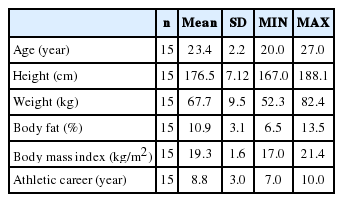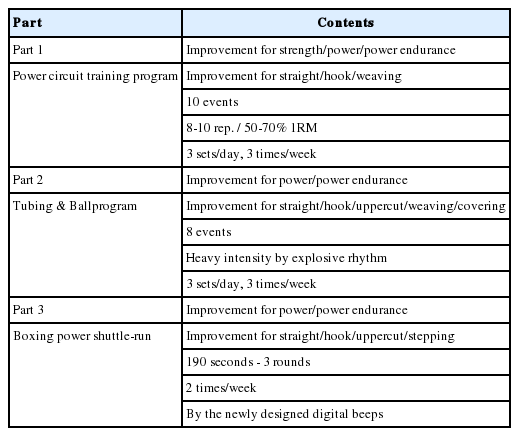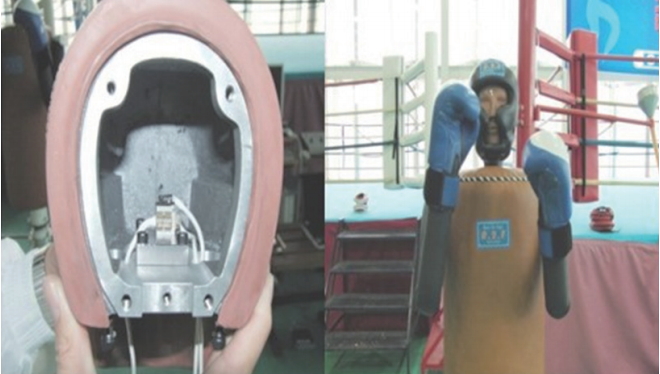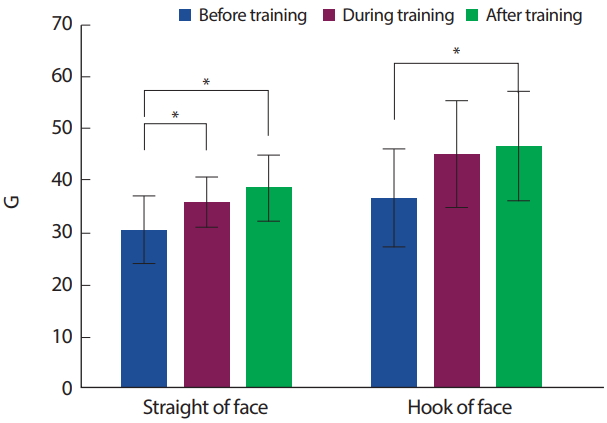Effects of Boxing-Specific Training on Physical Fitness and Punch Power in Korean National Boxers
Article information
Trans Abstract
PURPOSE
The purpose of this study was to investigate the effect of 16-week boxing-specific training on specific fitness and punch power in Korean national team boxers.
METHODS
Elite male amateur boxers (n=15) from the Korean national team participated in the study. Weight categories of the participants were light fly, fly, bantam, light, light welter, welter, middle, and light heavy. This boxing-specific training program was designed to improve strength and power, and punching power during pre-season for elite boxers. Boxing-specific training program was composed of three parts; power circuit training, tubing and ball training, and boxing power shuttle-run. The specific fitness such as strength and power and punch power were evaluated before, at the mid-way (8-week), and after the training for all the study participants.
RESULTS
As for maximum strength, there were significant improvements in bench press and squat between pre- and post-training. Both the absolute and relative strength of trunk flexion and extension were improved in the post-training compared to the pre-training. Right and left isokinetic power were also improved at the post-training compared to the pre-training. Punch power for facial straight and hook attacks showed significant improvement at the post-training compared to pre-training. Straight punch power was significantly related to the bench press (r=.515, p=.001), and the right arm extension power (r=.535, p=.001). Hook punch power was significantly related to the right arm extension power (r=.417, p=.006).
CONCLUSIONS
In conclusion, boxing-specific training was effective to the improvement of strength, power and punch power for elite amateur boxers.
INTRODUCTION
Boxing, one of the oldest combat sports, is characterized by high intensity performance during rounds with short interval between rounds which are not enough to provide a full recovery. The amateur (Olympic) boxing scoring system, 10-point-must-system, which replicates professional boxing’s one, appoints a winner at the end of each round based on the criteria such as number of quality punches on the target area, domination of the round, and etc [1,2]. For the quality punches and in return to avoid getting punches, boxers require technical and tactical skills and high levels of physical fitness [3]. Therefore, to achieve high performance in boxing, it is necessary for boxers to present high aerobic fitness, anaerobic threshold, strength and power as well as technique [4-6].
Boxing is aimed to deliver a clean and correct punch to the opponent without being punched in return [4]. The accuracy and strength of punches are strongly related to win in a boxing competition [7]. Punching impact force is one of the key success factors in boxing performance [8-10]. Since punches, major techniques in boxing, are extremely dynamic and brief actions, muscle power in both the upper and lower limbs is necessary for high-level boxing performance [11]. Coaches and researchers are seeking effective methods for developing muscle power in athletes. Recently, the optimum power load, defined as load capable of maximizing power output, method has been reported for an effective way to increase strength and power in different sports including boxing [12]. Although previous studies reported a high level of physical fitness as being a key factor for the performance of amateur boxing, there is few study regarding the association between physical fitness and punch power [4,13,14].
Sport-performance training and assessment techniques would attempt to target the physical fitness specific to sports [15-17]. Sports-specific training methods have been utilized in several sports such as throwing, soccer, taekwondo [18]. A sport-specific power training in collegiate throwing athletes led to an improvement in throwing velocity [19]. Also, technical interval training has been known as an effective training mode to enhance aerobic fitness in taekwondo player [18]. However, it has not been utilized sport-specific training to improve physical fitness and performance for elite boxers. Thus, the purpose of this study was to investigate the effect of 16-week sports-specific training on specific fitness and punch power in Korean national team boxers.
MATERIALS AND METHODS
1. Participants
Fifteen elite male amateur boxers from the Korean national team participated in the study (Table 1). Weight categories of the participants were light fly (LF, 46-48 kg, n=1), fly (F, -52 kg, n=1), bantam (B, -56 kg, n=2), light (L, -60 kg, n=2), light welter (LW, -64 kg, n=3), welter (W, -69 kg, n =2), middle (M, -75 kg, n =2), and light heavy (LH, -81 kg, n=2), and there were no heavy and super heavy in Korean national team at the time. The participants have won first-place titles and/or second places in the national qualification tournament in Korea 2012. After being informed of any risks associated with participation, each participant gave his written informed consent. This study was approved by the institutional review board of the Korea Institute of Sport Science.
2. Boxing-specific training to improve fitness and punch power in elite boxers
In this study the sport-specific training for elite boxers were formulated in order to enhance both of physical fitness and boxing performance during pre-season. This boxing-specific training program was designed to improve boxing-specific fitness components such as strength and punching power for elite boxers. Since the boxing-specific training in the study was executed in pre-season, it was focused to coordinate fitness and the boxing skills in a similar situation like an actual boxing matches, which were 3 rounds ×3 minutes with a one-minute interval between rounds. Boxing-specific training program was composed of three parts (Table 2); power circuit training (Fig. 1), tubing and ball training (Fig. 2), and boxing power shuttle-run (Fig. 3). In this study the power circuit training was conducted at the gym in the morning (10:30 to 12:00), and the tubing and ball training and the boxing power shuttle-run were performed at the boxing training center in the afternoon (15:30 to 17:00).
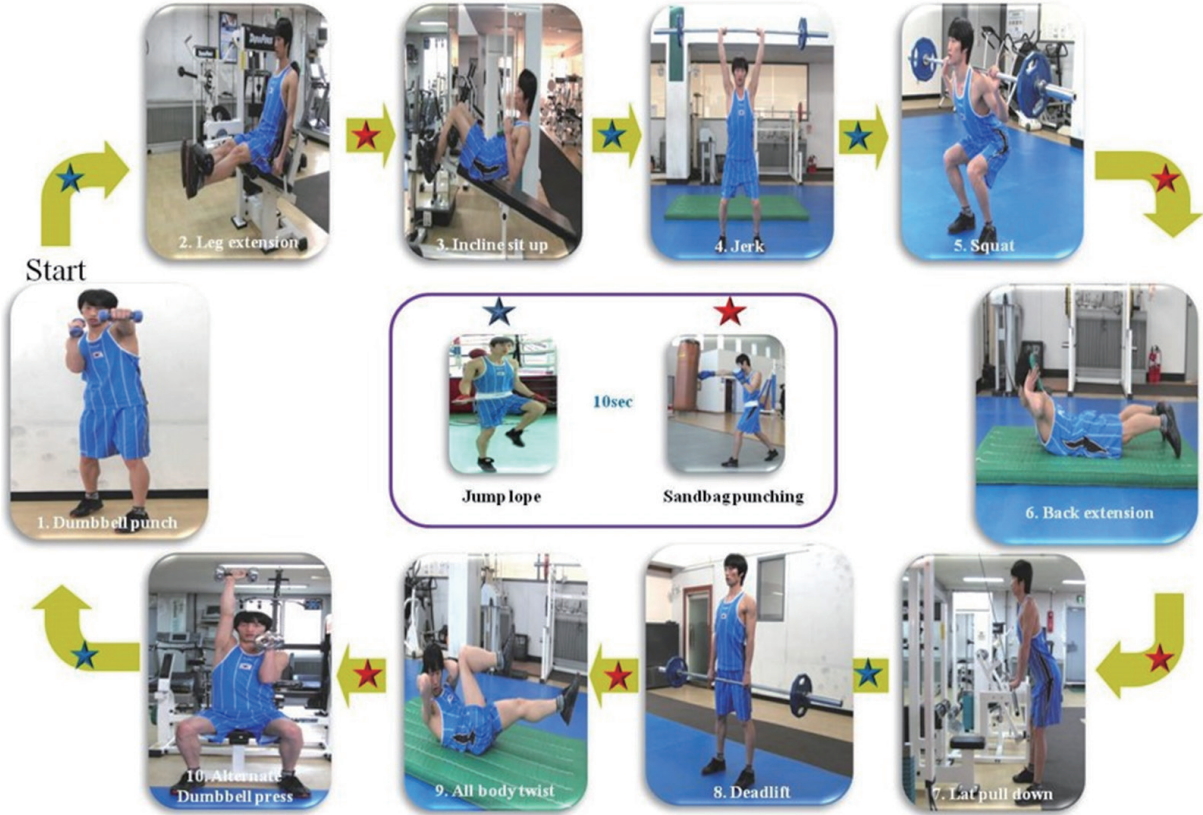
Sport-specific training for boxers: power circuit training program. Blue star mark represents dynamic rest between exercises with jump rope for 10 to 15 seconds. Red star mark represents dynamic rest between exercises with sandbag punching for 10 to 15 seconds.

Sports-specific field training for boxers: tubing and ball training program. Resistance tube (green-blue-black) and medicine ball (3-4-5 kg) were utilized. Three sets (8 to 10 reps) were performed with rest period for 7 minutes.
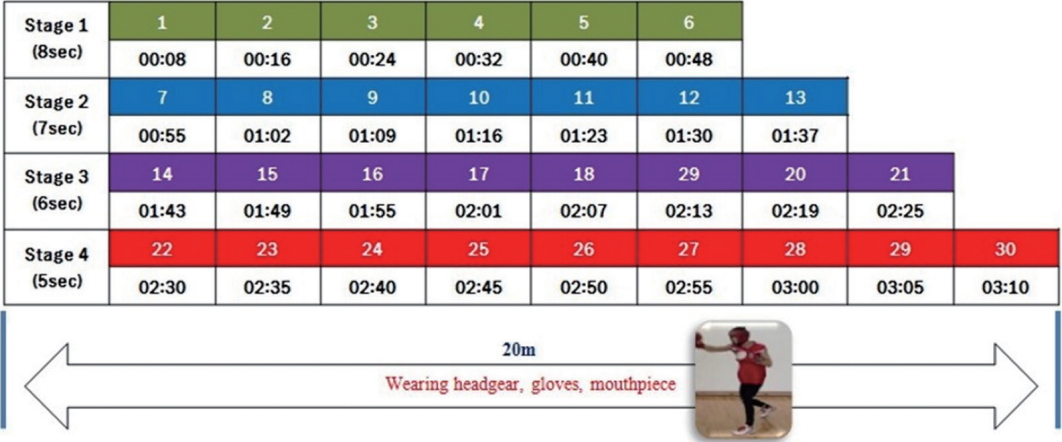
Sport-specific training for boxers: boxing power shuttle run program. One round was composed of four levels with 190 seconds. Performed with 3 round and rest period was 1 minute per round. From step 1 (8-second intervals) to step 4 (5-second intervals), Boxsers performed the shuttle run 30 time in each one-round. Step-by-step signal was presented by the newly designed digital beeps.
All the training was executed in the Korean National Training Center. The boxing-specific training was applied for 16 weeks. The power circuit training and the tubing and ball training were performed 3 sessions (3 sets/session) per week. A rest period between sets was 7 minutes. In each set the participants were asked explosively perform 8 to 10 repetition. For the power circuit training (Fig. 1) the intensity was set at 50 to 70% of 1 repetition maximum (RM). Various resistance tubes (green, blue and black) and medicine balls (3, 4, and 5 kg) were utilized for the tubing and ball training in Fig. 2. Training intensity and number of repetition were increased gradually during the training period. The boxing power shuttle run (Fig. 3) was performed 2 sessions (3 sets/session) per week. It was composed of four stages with 190 seconds into one round. The participants performed 3 rounds and took a rest for one minute between rounds.
3. Specific fitness measurements and punching power tests
The specific fitness and punch power were evaluated before, at the mid-way (8 weeks of the training period), and after the training for all the study participants.
1) Specific fitness measurement
For maximum strength, bench press and squat were measured using multi-function dynamometer (ACE-2000 Multi-Function, Ariel Dynamics Inc., USA) in kg. Isokinetic strength and power were measured using isokinetic dynamometer (Humac Norm, CSMi, USA); isokinetic strength of trunk was measured at 30°/sec, and isokinetic power of arm was measured at 180°/sec. For isokinetic strength and power, the participants were asked to perform maximum strength and power with flexion and extension for three times. Peak torque (Nm), a flexor/extensor muscle ratio (%) and average power for flexor and extensor muscles were measured.
2) Punch power measurement
For the punch power, the participants threw straight and hook by dominant hand on the dummy face. The dummy face was placed at the same height of the each participant. The participants practiced several times, and executed straight and hook for three times. The dummy face was connected to torso by spring for cushion the impact and flexible movement, and the dummy was placed on the ground (Fig. 4).
Impact of the participants’ hand on the target was measured by threeaxial (x, y, and z) acceleration sensor (Model 4630, Measurement Specialties, USA). Straight was mainly measured in x direction and hook was measured in y direction. Measuring range of the acceleration sensor was ±100 G and it was calibrated by the factory. The sensor has a built–in amplifier circuit, therefore, no external circuit was required and analog acceleration signal was output. The analog acceleration signal was converted digital signal with a National Instrument DAQ (NI 9215, USA) by 16-bit data. The data were sampled 1,000/sec for each axis and recorded as technical data management streaming (TDMS) file to have accurate time synchronization. Total acceleration was sum of all vector components (x, y, and z) and measured data were recorded as G unit (1 G =9.81 m/s2).
3) Statistical analyses
All the data were presented mean and standard deviation. One-way ANOVA with repeated measures was executed for specific fitness and punch power variables to find out differences in the boxing-specific training programs and least significant difference (LSD) was used for post-hoc in the study. Pearson’s correlation analysis was applied to examine the relationship between specific fitness and punch power. Statistical analyses were performed using SPSS version 20. The statistical significance level of the analysis was set at p<.05.
RESULTS
1. Changes in specific fitness for elite boxers
As for maximum strength, there were significant improvements in bench press and squat (p<.05) between pre- and post-training, and in squat (p<.05) even between mid- and post-training (Table 3). The improvements of trunk and arm strength were presented in Table 2. Both the absolute and relative strength of trunk flexion and extension were improved in the post-training compared to the pre-training. Improved results were shown in trunk flexion and extension at post-training compared to pre-training. Improved results were also shown with significant differences in isokinetic power of right and left arm at the post-training compared to the pre-training.
2. Change in punch power
Punch power for facial straight (p<.05) attacks showed gradual improvement at the mid- and post-training compared to pre-training. Punch power for facial hook (p<.05) attacks also showed gradual improvement at the post-training compared to pre-training (Fig. 5).
3. Correlations among physical fitness and punch power
The correlations between punch power and specific fitness were presented in Fig. 6. Straight punch power was significantly related to bench press (r=.515, p =.001), and right arm extension power (r=.535, p =.001). Hook punch power was significantly related to right arm extension power (r=.417, p =.006).
DISCUSSION
This study investigated the effects of boxing-specific training in improving the strength and punch power for elite boxers. Due to the characteristics of national boxing players with the peak competition performance, it was restrictive to have a control group composed of athletes with similar competition performance. Therefore, a control group was not formed since it would cause moral problems by having a control group not involved in the systematic training as they have been equally joined in the athletes’ village. As previous studies have been conducted, participants of this study were designated to be a training group that has been continuously conducting sport specific training [13,20,21].
Maximum strength changes in the upper and whole body showed a large improvement with significant differences by period. Anderson et al. [22]. has also reported that training combining expansibility and free weights improved the level of maximum power in the upper and whole body within seven weeks, which shows consistency with our study. It is considered that boxing-specific training proves to improve muscular strength and power in the upper and whole body for amateur boxing players who are more familiar with resistance training. As Paton and Hopkins [23] have suggested that a combining power exercise and high-intensity resistance training not only improves sprint capacity and endurance, but also improves exercise efficiency and anaerobic threshold level, the boxing-specific training in this study brings positive improvements in specific fitness.
Punch is one of the main factors for high performance in boxing [10]. The accuracy and strength of punch are key indicators for winning in a boxing match [7]. Boxers use two types of punches, hook and straight. A hook is performed by turning the core muscles and swinging the arm, and is usually thrown by the lead hand aimed at the chin. When throwing a hook, the boxer shifts his body weight to the lead foot, allowing him to pivot his lead foot and generate kinetic energy through the hip/torso/shoulder, swinging his lead fist horizontally toward the opponent. Thus, core strength is essential to utilize strong punch power and upper body weaving in boxing. Depending on smooth movement of core muscles when depending, significant improvements in core flexor and extensor muscles would directly affect the which would lead to the boxing performance. Therefore, coaches and fitness trainers should also organize their specific training for appropriate technical-tactical and physical conditioning that may facilitate a winning advantage [24,25].
Even isokinetic power of arm factors was significantly improved by the boxing-specific training. Ratamess et al. [26]. has shown that there were significantly improved results in lower and upper maximum strength and power level among female athletes who had practiced a combining resistance training and plyometric training. Ronnestad et al. [27]. also recommended a combining of muscular and plyometric training to improve the strength and power level of elite athletes. Therefore, power training consisting of various types of explosive elasticity exercises should be suggested to improve the upper body power of boxing players.
The latest trend of world boxing is power boxing combined with defensive covering. In particular, as for the attack techniques, punches, such as facial straight and hook, are mainly used. The Korea Institute of Sport Science has developed measurement equipment to analyze punch power in boxing. Therefore, even in this study, using the measurement equipment, punch power was improved after the boxing-specific training. In this study straight punch was significantly improved at the posttraining (38.55±6.42 G) compared to the pre-training (30.51±6.53 G). The straight punch was converted to 2,313 N (38.55 G×60 kg) if applied weight for 60 kg. This result was similar to the England boxers 2,643 N [6], but seemed to be low compared to Austrailain boxers 3,360 N [28]. Hook was also significantly improved at the post-training (46.64±10.58 G) compared to (36.75±9.43 G). The hook was converted to 2,798 N (46.64 G×60 kg) if applied weight for 60 kg. This result was comparable to England boxers 2,588 N [8].
As a result of the sport specific training, if both power and punch power have been increased, it could be a driving force to power boxing. Also, it is meaningful that Korean boxing players can also execute strong straight and hook attacks in infighting for power boxing.
In conclusion, the results have been generally improved for specific fitness and punch power after 16 weeks of sport specific training, helping Korean amateur boxing players who prefer out boxing strategy to think that they also can execute power boxing. Therefore, it would be extremely helpful to establish successful competition strategies.
